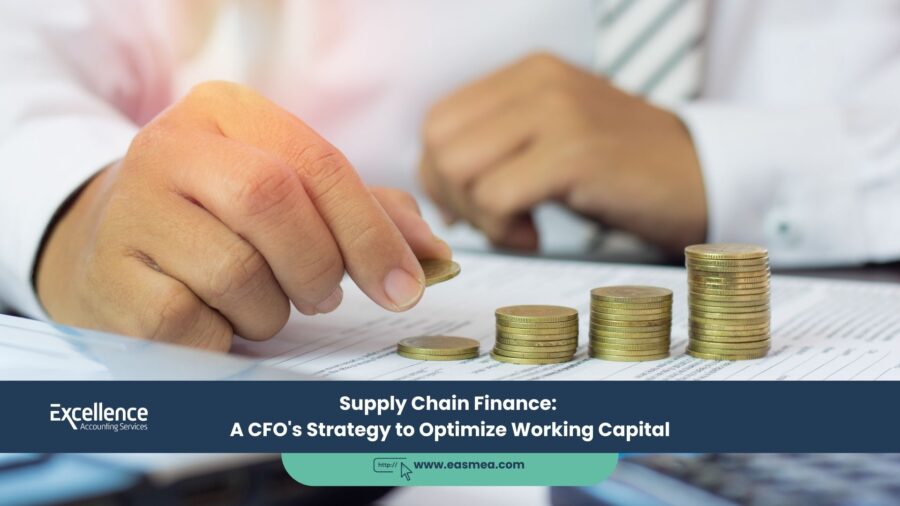Supply Chain Finance: A CFO’s Strategy to Optimize Working Capital
For any Chief Financial Officer (CFO), managing working capital is a perpetual balancing act. On one side, the procurement team is negotiating longer payment terms with suppliers to preserve cash (increasing Days Payable Outstanding, or DPO). On the other side, those same suppliers are pushing for earlier payment to manage their own cash flow. This inherent conflict can strain supplier relationships and introduce fragility into the supply chain. But what if there was a way to achieve both objectives simultaneously?
- Supply Chain Finance: A CFO's Strategy to Optimize Working Capital
- The Traditional Working Capital Conflict
- How Supply Chain Finance Works: The Three-Step Process
- The Strategic Benefits from a CFO's Perspective
- Implementing Strategic Finance Solutions with Excellence Accounting Services (EAS)
- Frequently Asked Questions (FAQs)
- Unlock the Cash Trapped in Your Supply Chain.
This is the strategic power of **Supply Chain Finance (SCF)**. Also known as reverse factoring, SCF is a set of technology-based solutions that creates a win-win scenario for both a large buyer and its suppliers. It allows the buyer to extend their payment terms while simultaneously giving their suppliers the option to get paid earlier. For a modern CFO, SCF is not just a payment tactic; it is a powerful strategic tool for optimizing working capital, de-risking the supply chain, and strengthening relationships with key partners.
This guide will provide a CFO’s perspective on Supply Chain Finance in the UAE. We will break down how it works, explore its significant strategic benefits, and explain why it has become an essential component of a world-class finance strategy.
Key Takeaways
- SCF Solves the Working Capital Dilemma: It allows buyers to extend payment terms (improving their cash flow) while offering suppliers the option to be paid earlier (improving theirs).
- A “Win-Win-Win” Solution: The buyer wins with better working capital. The supplier wins with early, low-cost financing. The bank wins by financing a low-risk, approved invoice.
- Strengthens the Supply Chain: By providing liquidity to your suppliers, you make them more financially stable, reducing the risk of disruption in your supply chain.
- Leverages the Buyer’s Credit Rating: Suppliers can access financing at a much lower interest rate, based on the creditworthiness of their large customer (the buyer), rather than their own.
- Technology-Driven: Modern SCF programs are run on sophisticated fintech platforms that seamlessly connect the buyer, supplier, and financial institution. This is a key area for strategic CFO services.
The Traditional Working Capital Conflict
The core of the problem lies in the opposing goals of the buyer’s and supplier’s finance departments:
- The Buyer’s Goal (Your Company): To hold onto cash as long as possible to maximize working capital. This means pushing for payment terms of 60, 90, or even 120 days.
- The Supplier’s Goal: To get paid as quickly as possible to fund their own operations and reduce their reliance on expensive overdrafts or loans. They push for terms of 30 days or less.
This conflict creates friction. Aggressively extending payment terms can damage relationships and even push smaller, critical suppliers into financial distress, creating a significant risk for your business.
Supply Chain Finance transforms the payment term negotiation from a zero-sum game into a collaborative partnership.
How Supply Chain Finance Works: The Three-Step Process
SCF is a simple concept that involves three parties: the Buyer (your company), the Supplier, and a Financial Institution (a bank or fintech platform).
- Invoice Approval: The Supplier delivers goods or services and submits an invoice to the Buyer. The Buyer verifies the invoice and approves it for payment on, for example, a 90-day term, uploading the approved invoice to the shared SCF platform.
- Early Payment Option for Supplier: The Supplier can now see the approved invoice on the platform. They have a choice: wait 90 days for the full payment, or click a button to request an immediate early payment from the Financial Institution.
- Settlement: If the Supplier chooses early payment, the Financial Institution pays them the full invoice amount minus a small financing fee. On day 90, the Buyer pays the full invoice amount to the Financial Institution as originally agreed.
The magic of SCF is that the financing fee charged to the supplier is based on the **Buyer’s** strong credit rating, not the supplier’s. This means the supplier gets access to much cheaper financing than they could ever get on their own.
The Strategic Benefits from a CFO’s Perspective
For a CFO, implementing an SCF program delivers a powerful range of strategic advantages.
1. Working Capital Optimization
This is the primary benefit. By standardizing payment terms at a longer date (e.g., 90 or 120 days) across your supply base, you can significantly improve your company’s cash conversion cycle and free up substantial amounts of working capital for investment in growth or other strategic initiatives.
2. Supply Chain De-risking and Stabilization
Your company is only as strong as its weakest link. If a critical supplier fails due to financial distress, your entire operation can grind to a halt. By offering an SCF program, you are providing your suppliers with a stable, low-cost source of liquidity. This makes them financially healthier, more resilient, and more reliable partners.
3. Improved Supplier Relationships
Instead of being the “bad guy” pushing for longer terms, you become a strategic partner offering a valuable financial solution. This transforms the relationship from a contentious negotiation into a collaborative partnership, which can lead to better service, preferential treatment, and more innovation from your supply base.
4. Potential for Cost Reduction
Some companies use the benefits of SCF as a negotiating tool. They may be able to negotiate better pricing or eliminate early payment discounts they previously offered, as suppliers now have a more efficient way to manage their cash flow. This can lead to a direct reduction in the Cost of Goods Sold (COGS).
Implementing Strategic Finance Solutions with Excellence Accounting Services (EAS)
A Supply Chain Finance program is a high-level strategic initiative that requires expert financial planning and execution. EAS provides the strategic financial leadership to help you design and implement such programs.
- Strategic CFO Services: Our outsourced CFOs can lead the strategic analysis for an SCF program, building the business case, assessing the impact on working capital, and selecting the right banking and technology partners.
- Working Capital Management: We provide in-depth analysis of your entire working capital cycle, from accounts receivable to accounts payable, identifying opportunities for optimization.
- Supplier Relationship Management: As part of our business consultancy, we can help you segment your supply base and develop the communication strategy needed to successfully onboard suppliers to an SCF program.
Frequently Asked Questions (FAQs)
No, they are very different. In factoring, a supplier sells its invoices to a third party at a significant discount, and the factor then chases the buyer for payment. It is often seen as a sign of a supplier’s financial distress. SCF is initiated by the buyer, is based on an approved invoice, and the financing cost is much lower.
The supplier pays the small financing fee, but only if they choose to take the early payment option. The fee is a direct deduction from the payment they receive from the bank.
Historically, yes. However, with the rise of fintech platforms, SCF solutions are becoming increasingly accessible to large and medium-sized enterprises with strong credit ratings and a significant amount of spend with their suppliers.
This is a key accounting question. For the buyer, the amount owed is generally still classified as a standard “trade payable.” However, accounting standards require careful assessment to ensure the program doesn’t reclassify these payables as bank debt, which could impact debt covenants. This requires expert accounting advice.
They agree because the buyer is offering them a valuable trade-off. In exchange for the longer term, the supplier gets access to an early payment option at a very attractive financing rate, giving them full control and predictability over their cash flow.
The main risks are operational and reputational. The technology platform must be robust. The onboarding and communication with suppliers must be handled well. There is also the accounting risk of correctly classifying the payables, which requires professional guidance.
Dynamic discounting is a related but different solution where a buyer uses its own cash to offer suppliers early payment in exchange for a discount. The discount is “dynamic” because it’s often on a sliding scale—the earlier the payment, the larger the discount. SCF uses a third-party funder, allowing the buyer to preserve its own cash.
The CFO is typically the executive sponsor. They are responsible for building the internal business case, securing buy-in from procurement and treasury, leading the selection of the bank/fintech partner, and overseeing the successful rollout to key suppliers.
Yes. The principle is the same. As long as the supplier submits a valid invoice for services rendered and the buyer approves that invoice, it can be financed through the SCF platform.
You should evaluate providers based on several factors: their technology platform’s ease of use, their global reach (if you have international suppliers), the size of their funding network, their experience in your industry, and the transparency of their fee structure.
Conclusion: A Strategic Lever for Financial Excellence
Supply Chain Finance is a powerful testament to how modern finance, enabled by technology, can transform a traditional point of conflict into a source of mutual value. For the strategic CFO, it is a sophisticated lever that can be pulled to unlock significant working capital, build a more resilient and collaborative supply chain, and drive a tangible competitive advantage. It represents a fundamental shift from a transactional to a strategic approach to managing the financial ecosystem of a business.
Unlock the Cash Trapped in Your Supply Chain.
Contact Excellence Accounting Services to explore how strategic working capital solutions like Supply Chain Finance can transform your business.




